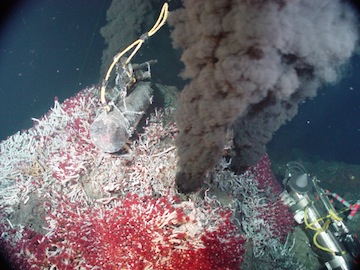350615-virus bacteria.jpg

Some viruses living in the deep ocean near thermal vents can "steal" energy from bacteria. Credit: National Oceanic and Atmospheric Administration
Anyone who’s had the flu knows that a virus can really drain your energy. But some viruses found in the deep ocean seem to take this energy draining to the extreme. They force bacteria to “burn” their energy reserves, then use that energy for their own.
The viruses were found around undersea hot springs known as thermal vents. Water heated to hundreds of degrees by pools of molten rock below the sea floor bubbles up into the ocean, carrying dissolved minerals along with it. These minerals serve as the energy source for bacteria, which are the first link in a food chain that can include tube worms, shrimp, and other organisms.
Marine scientists sampled the water around six of these vents in the Gulf of California and near American Samoa in the western Pacific Ocean.
The water contained a type of bacteria that lives off sulfur dissolved in the hot water, along with several previously unknown viruses. The DNA of these tiny organisms revealed that the viruses have genes that are similar to those the bacteria use to produce energy from the sulfur. That suggests that the viruses force the bacteria to produce extra energy, then “steal” it for themselves.
Marine biologists had found a similar relationship between viruses and bacteria in shallow waters, where the main source of energy is sunlight. But this is the first time they’ve seen it in the deep ocean, where energy comes from chemical elements dissolved in the water — a fight over natural resources at the bottom of the sea.

